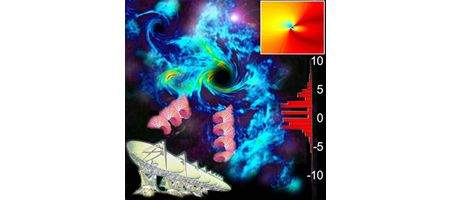It should be possible to spot spinning black holes using ground-based telescopes, says a team of astronomers and physicists, because of their twisting effect on spacetime.

Very massive objects such as black holes warp space-time so that the path of any passing light is bent – so-called gravitational lensing.
But general relativity also predicts that when a black hole rotates it will drag space-time around with it, creating a vortex. This forces all nearby objects, including photons, to follow that rotation.
So far, while it’s believed that the supermassive black holes at the core of many galaxies rotate, there’s been no direct evidence. The rotation of the Milky Way’s black hole, for example, is suggested by the velocity distribution of stars within the galaxy.
But there’s a lot of uncertainty to this prediction, as it’s not known exactly how much matter, particularly dark matter, the galaxy contains. It means astronomers can’t agree on whether the black hole is rotating quickly or slowly.
But Fabrizio Tamburini of the University of Padova in Italy and his colleagues say it’s possible to detect the rotation by measuring changes to the light from a distant star or from the disk of accreted material surrounding a black hole.
A wavefront travelling at right angles to the black hole’s axis of spin will get twisted as it passes close to the black hole, since half of the wave front will be moving in the direction of advancing space-time and the other half in the direction of receding space-time.
The researchers used a computer simulation to model the phase distribution resulting from the rotation of the Milky Way’s black hole – and found that this variation ought to be visible from the ground.
They say the way to measure it is to point an array of radio telescopes at the centre of the galaxy, using different telescopes to observe different sections of the approaching wave front, and then superimpose these segments to work out their relative phase.
Tamburini believes that his group could carry out such measurements within two years using an existing array of radio telescopes, such as the Very Long Baseline Array in the US, or the LOIS-LOFAR in Europe – if he can get the funding.






